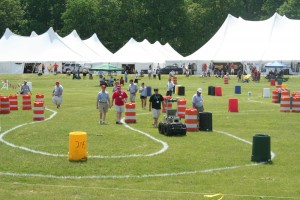Robotics team takes home 3rd at IGVC

Oakland put together a strong performance at the 19th annual Intelligent Ground Vehicle Competition held on campus June 3-6. Oakland took home 3rdplace for both design and standardization of controls, earning $3000 for the robotics program.
Along with the OU robot, “Botzilla,” the team consists of a mix of 15 graduate and undergraduate students who estimate they have put 1500 man-hours into readying the robot for competition, beginning last year.
“It’s a lot of time,” said graduate student Steve Grzebyk, who spent an entire year on his part alone.
The competition incorporated several distinct components, including obstacle navigation, the search of various points on a course via GPS and speed control. In addition, the team met several requirements for the standardization of their control system.
Obstacle avoidance was a particular focus for the team.
“The vision system that the robot uses to detect objects in its surroundings is the most difficult system to develop,” said Micho Radnikovich, Ph.D. student and president of the Oakland Robotics Association.
Botzilla uses a camera, which feeds images to a computer. Using those images and a sophisticated bit of computer code, the robot is able to negotiate obstacles and maintain lane position.
Another feature of this year’s robot is its innovative steering system
“(The robot can) steer its front and back wheels independently, which gives it a lot of mobility,” Radnikovich said.
Botzilla also has a black fiberglass exterior case, essentially creating a rain proof cover over the system’s sensitive wiring.
With a sharp exterior, combined with a delicately structured system and loads of work, Oakland’s team was able to find success.
The design portion involved submitting a detailed written report illustrating how the robot works as well as an estimated cost of production. This is followed by an on-site oral presentation in front of a panel of competition judges.
The Joint Architecture for Unmanned Systems (JAUS) challenge involves standardizing control mechanisms so that they may be compatible with military systems.
In this case, the robot was required to follow commands to drive to GPS points as directed by the JAUS system.
The 2011 finish represents a significant improvement after finishing sixth in 2010.







